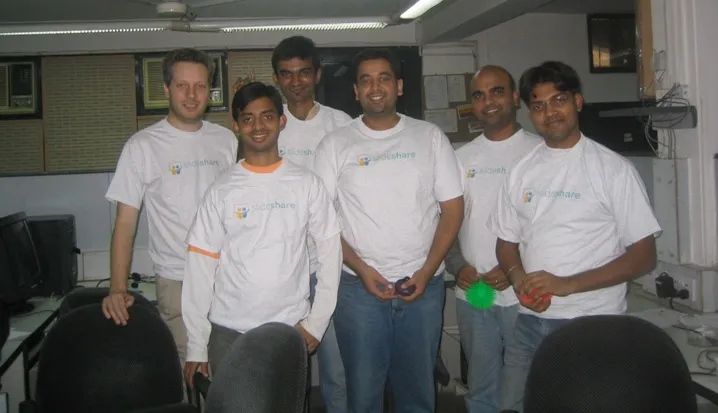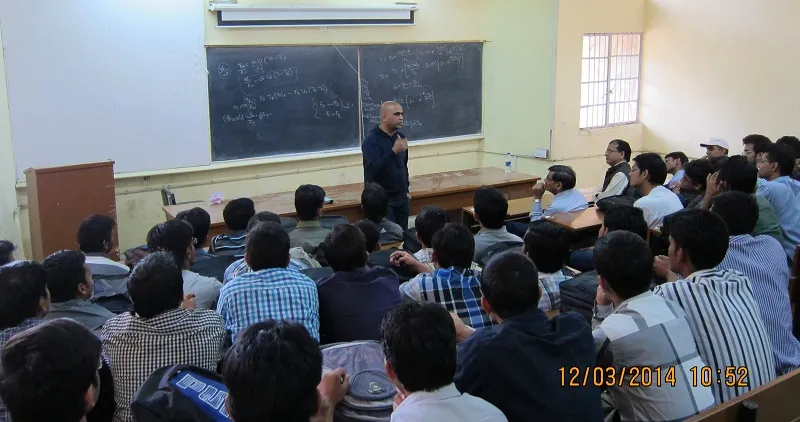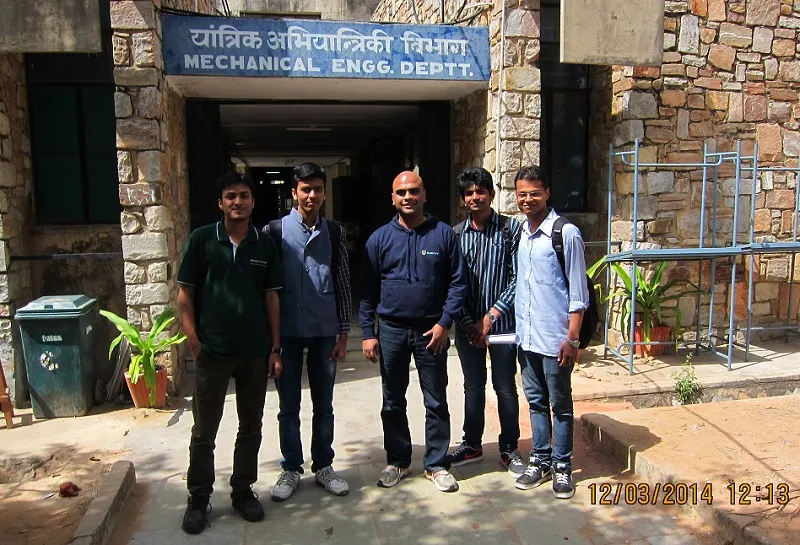[Techie Tuesdays] Amit Ranjan—the entrepreneur who crossed the startup-government chasm
When SlideShare was acquired by LinkedIn in 2012 for $119 million, COO and co-founder Amit Ranjan could never have imagined that he would one day work with the government. A tinkerer by instinct, the protagonist of our Techie Tuesdays for today is the architect of the DigiLocker and OpenForge, who crossed the startup-government chasm successfully.
Amit Ranjan has always been a tinkerer. It was this quality that got him beaten up as a kid for opening up toys and gadgets (and trying to put them back together before getting caught). The same quality almost left him dead at the age of nine. And years later, when he started a business that was eventually sold for $119 million, it was to be blamed on (or rather credited to) this very quality.
A techie at heart, a manager by degree, and a pragmatist by behaviour, Amit has often opted for the road less travelled.

The Bengali connection
Though Amit’s family belongs to Allahabad, his father moved to Kolkata (then Calcutta) to work for the typewriter company Remington Rand. Amit was born in Kolkata and spent the first 10 years of his life there. Th youngest (and naughtiest) of the two sisters and two brothers, he owes his entrepreneurial journey to his tinkering nature. Talking about the trait that almost cost him his life, he recalls,
“After Diwali celebrations, we went on to scout for the leftover explosive powder of the burnt firecrackers. We tried to put it together to make a sutli bomb. It didn’t go well and blasted at the wrong time. I was bedridden for six months.”
A year later, his father met with an accident and the family decided to move to Allahabad to be close to relatives. By then, Kolkata’s influence on Amit was already evident—he spoke Bengali, had Bengali friends, and was even mistaken for a Bengali in college and at the workplace.
Amit went to the Regional Engineering College, Jaipur (now National Institute of Technology) and studied mechanical engineering. He considers himself an information-driven person and was active in quizzing and related activities in school and college. He says, “It played an important role later in SlideShare because it is a very information-centric platform.”
Also read - Sandipan Chattopadhyay — the statistician behind the 160x growth of Justdial
The herd mentality, the grind, and the shift
Looking back, Amit regrets not having given enough time and thought to understand what he liked and what his instincts were. He was caught up in the herd mentality and went for an MBA (dropped the idea of MS because of laziness). At Faculty of Management Studies (FMS), when he had to choose between the two main streams for majors—finance and marketing—he chose the latter just because it was what the majority was doing.
After graduation, Amit joined Asian Paints as an area manager, where he was responsible for sales, godown, shipments, and logistics. In an unintended way, the operational grind at Asian Paints was the stepping stone to startup experience for Amit. After four years of rich experience, Amit started looking for opportunities in marketing and joined PepsiCo. He took up the role of the national key accounts manager and handled relationships with modern trade (Big Bazaar and others). However, in a few months, Amit was struggling because of the expectation-reality gap. He realised that his career was not in line with his key instincts.
The leap of faith
By this time, Amit’s sister, Rashmi Sinha, had finished her PhD in cognitive psychology and was teaching Human Computer Interaction and Statistics at the Information School, UC Berkeley. Amit’s brother-in-law, Jonathan Boutelle, was working in a dot-com company called Commerce One. While Amit used to speak to both regarding personal matters, he never really discussed business with them.
Rashmi was working very closely with Hal Varian, who was the chief economist at Google. After spending 10 years in academia, she realised that her instincts were towards entrepreneurship. Meanwhile, Amit started realising that the instincts that drive an MBA are different from the ones that drive an engineer. He says,
MBAs are about optimising/managing whereas engineers are builders. It hit me like a sledgehammer. At this point, all three of us were dissatisfied with what we were doing. Each one of us had an itch (to start up). This is where we took our leap of faith.
Amit recalls that this was the time when startups and entrepreneurship didn't exist in the Indian lexicon. Both Rashmi and Jonathan quit their jobs to start a user experience consulting company, Uzanto Consulting. Given India’s cost advantage, Amit was keen to build things here. The founders decided to try it out for 18 months. They hired a team of four engineers in Delhi and Rashmi and Jonathan travelled to India once every four–five months.
While designing eBay’s information architecture, Rashmi felt the need to build a UX research software or an online suite which addresses the problems product managers and designers face. That’s when she decided to work on MindCanvas, which could be described as the meeting point of gamification and user research. Amit says,
If you can make the experience of giving feedback better, then you can get actually better feedback. And that feedback can be looped back in the product management.
This principle was used while building MindCanvas, and later SlideShare as well.

Building team - I
With zero technology experience and coming from PepsiCo, it was a big challenge for Amit to build a team in Delhi. The team spent about 18 months building the product using the waterfall model. Amit explains,
“We tried to design the ideal thing, put it on the drawing board, and get on with the software development cycle (of iterations). Initially, we thought we'd build the product in six months, but then it took us 18 months.”
The final product came out as a powerful tool and the initial beta (paid) users of MindCanvas included teams like Microsoft and Yahoo! But the founders were convinced that the waterfall model wasn’t the best way to develop the product.
They had also realised that the best way to hire people when you don't have money is by blogging. Amit adds,
When people come to work for you initially, they don't come to work for the startup, they come to work for the founders. So, the founders have to have credibility and authenticity.
All three started actively blogging in their respective areas. Amit started a blog on technology and on running a startup from India; Jonathan used to write about technology; and Rashmi wrote on UX. They eventually got a good readership, and their first few employees came from the blogs.
Since Amit didn’t have a technology background, he learnt from the internet and spent time understanding algorithms and how they work. He says, “I thought I should be able to stand at a whiteboard and talk sense to an engineer.” He adds, “If you don't know anything, tell the engineers that you don't know. People respond positively to it. If you try to project something you're not, you'll just get caught and you may get into a quagmire.”
Thirty percent of Amit’s time was being spent on office management, 30 percent on project management (making mockups and performing competitor analysis—product, design, UX), and the remaining 40 percent on team collaboration and management.
Related read - Meet the chief architect of Aadhaar, Pramod Varma
Divergence with instincts and the birth of SlideShare
In 2006, Jonathan attended the very first BarCamp in Silicon Valley organised by open-source advocate Chris Messina. On his next visit to India, he asked if a similar unconference event could be organised here. Finally, over 70 people attended India’s first unconference, held at the Adobe office in Noida and organised by Amit and a few others. This is where the SlideShare story started. Amit recalls,
“People asked for the presentations to be shared after the event. Somebody gave a pen drive, some offered to burn CDs, and a few said they would email. We were caught in between the speakers and audience. We started looking for a tool on the internet to share the presentations. We thought since it’s so easy to share photos (Flickr) and videos (YouTube), there would be something for presentations.”
However, there was nothing of the sort to be found, and Amit realised why—there was no technology that could take PowerPoint, OpenOffice, or Keynote files and convert them into a format that could work on browsers across devices. The founders then chose two people from the MindCanvas team to build an open-source tool engine which could convert a PowerPoint (or OpenOffice or Apple file) presentation into a final format that works on (internet) browser. They were successful in building the playback technology as a solution to the problem which formed the player of Slideshare and exists till date. They used Ruby on Rails as it was rumoured to be optimised for developers’ happiness and speed of iteration rather than enterprise readiness.
Three months into SlideShare, Rashmi, Jonathan, and Amit took the call to shut down MindCanvas as they wanted to focus on one thing and SlideShare’s trajectory promised a lot.

Sliding through SlideShare
Kapil Mohan was SlideShare’s employee number one. He, along with two others, had built a product around RSS feed which got acquired by a Silicon Valley company. The second employee, Vishnu Gopal, hailed from Thiruvananthapuram and had to fight with his parents to come to work in Delhi. Both Kapil and Vishnu built the stack for SlideShare.
There were no benchmarks for SlideShare to follow, which Amit believes was both good and bad. He says,
The bad part was that you have to start from first principles for everything—how to hire people for Ruby on Rails, how to build the product, how to handle legalities like making an Indian subsidiary. The good thing is that nothing constrains you so you use your instincts and proceed.
Since SlideShare was building things for a global audience from the ground up, they had to build an engine which was a combination of technology, product, and design. Given that Ruby on Rails was the new kid on the block, the founders decided to hire freshers and train them. Amit built a hiring engine which was a methodology to tell if a person (with his/her résumé ) irrespective of his/her background, was good for the company or not. This solved a major problem for SlideShare.
In 2008, SlideShare raised funding and in 2009, the company started thinking about monetisation and revenues as the product had reached the first base.
Also read - Baishampayan Ghose — the Agartala boy who is all set to become a farmer after co-founding 3 startups
The LinkedIn deal
In 2009, SlideShare partnered with LinkedIn for their application platform. It was an invite-only platform for eight–10 companies. The company built a mini SlideShare app on LinkedIn. The other products who partnered included YouTube and Wordpress. After two years, they decided to shut down the application platform as it wasn’t doing well. But the SlideShare app was an outlier and LinkedIn explored the possibility of an acquisition. In 2012, LinkedIn announced the acquisition of SlideShare.
Amit mentioned that everyone including the peon and receptionist of the company had stock options in SlideShare and made money.
After the acquisition, he soon realised that life in an acquired company is not the same as life in a startup. He says,
These acquisitions in technology play in a certain way. First you have the freedom, then the integration of technology starts, followed by the integration of the team.
One year into the acquisition, the balance of power started shifting to Mountain View, California and after three years, LinkedIn decided to move the Delhi team to Bengaluru (or San Francisco).

Crossing the startup-government chasm
After quitting SlideShare, Amit’s plan was to take a year or two off and then start another company but things didn’t go as planned. He says, “I was volunteering with iSPIRT and they wanted some help in Open API policy in Delhi. As a part of that policy discussion, I helped them out and met some government people. They got to know about my background. In one of the meetings, they mentioned they needed someone to run a project and that my background fit (the requirement).”
He spoke to Sharad Sharma and Nandan Nilekani and understood the uniqueness of the opportunity. This looked intellectually challenging and offered him a chance to build something for the government (and people). He agreed to it eventually.
He recalls,
My startup experience taught me a lot of things, but I had to recalibrate my expectations to do this. I had to start from zero. I knew that if I didn't have the humility to accept this, it wasn’t going to work. While I had startup experience, I couldn’t dial back to it too often.
Architecting DigiLocker
When Amit joined, DigiLocker was a theoretical concept with one proof of concept (PoC)made by the Government of Maharashtra, which had some users.
Given its dependency (to have issuers on board for the digital documents), DigiLocker is different from the other layers of IndiaStack like eSign or UPI. These are APIs that can be plugged into a workflow at any stage and have little downstream dependency. To start off with, the concept of the digital document (as an entity) wasn’t recognised in India. While digital records find a passing mention in the IT Act, they are few in number— almost all the processes are on paper. The concept of DigitalLocker wants digitisation to happen. Unlike UPI and eSign, it cannot be used immediately after registration as the ecosystem is still being built. Amit explains the entire situation with a beautiful analogy:
Imagine yourself designing a city's transportation system. You'll need the vehicles (platform), fuel, and highways. Translating this into DigiLocker terms, the platform is the product and the API, the fuel is the digitised documents, and the highway is the ecosystem which is being built. Now, the question was what should be built first and our bet has been to work on both fuel and cars. But the bigger entry barrier is with fuel as people may not even have documents (digitisation is the next step for them).
Related read - Ditch your driving licence for Digilocker, Digital India’s solution for paperless proof documents
For Amit, the legacy system, fear of technology, fear of change, and cost implications are some hurdles on the way. Though the Ministry of IT is building this department, they don't own any of the fuel. The fuel is with UIDAI, state education boards, the transport department, and others. It's the DigiLocker team’s job to convince each of them (departments). Amit considers this the biggest challenge, even bigger than creating the actual platform.
DigiLocker has reached the first base. It has over 25 entities (CBSE, transport department, state government applications) and an integration of over 150 types of documents.

Building the platform
One of the IndiaStack team’s biggest learnings from Aadhaar was that even if you get expertise to build platforms from outside, you can’t have them moving within the government easily. And hence, Amit was assigned Debabrata Nayak, the Project Director (Open-Source Collaboration) of the National e-Governance Division as the Technical Director of DigiLocker. Debabrata had a team of 10 people working with him, and Amit hired another 10 engineers and 10 people in onboarding (similar to sales and business development). The team has pitched to more than 200 entities so far from central, state, and local levels.
To an extent, Amit runs the DigiLocker like he ran SlideShare. He says,
I follow some of the core methodologies and principles (though not at the same level). We understand the objectives and goals at the broader level and then break it to the product level. We have given a lot of importance to product and design.
At many places, Amit has helped the system (and people in it) understand that there’s an art and science behind building these platforms while approaching them realistically. Usually, in government systems, it is mandatory for any product to have a user manual in 10 different languages available on the homepage. Amit resisted this idea and explained using Facebook’s example—it doesn’t have a manual because the product is built in such a way that it is not required. Since most of the people in the government are Facebook users, they understood it and it hit them hard.
DigiLocker uses a Linux stack and an open-source tool called ownCloud. While the front-end app layer is in PHP, MariaDB and MongoDB are used for data. It’s hosted in the NIC centre using government cloud.
The platform is built completely on open source. Currently, there are 25 issuers on DigiLocker who have issued about 1.65 billion documents including Aadhaar cards, driving licences, LPG consumer cards, income certificates, caste certificates, etc. The platform has five million users. The government has also started issuing licences for public and private digital lockers which will be like the government digital lockers. It's a distributed architecture and interoperable system. For example, if you have some documents in a government locker and some in a private one, you can access both using a common key (like Aadhaar).
Amit responds to the burning question of security concerns(is there a data security concern),
Yes and no. Yes because as the modes (of accessing data) increase, theoretical risk increases. No, because the digital locker doesn’t take documents at the core. This means that the CBSE data is with CBSE, transport department data is with them (and so on). A digital locker is just a thin layer in between which has the access URI to these.
You may also like: Meet Arun Ganesh, the 29-year-old map man of India
GitHub of e-Governance: OpenForge
Amit has also worked on OpenForge which was launched recently. It's like the GitHub of e-governance. It is trying to solve the problem of fragmentation in the government. Almost all the states and UTs (35 in number) have different transport applications with minor variations which can be achieved by small customisation. It’s not cost-effective to pay for the same software multiple times (by different states, in this case). Sharing of government (applications) code solves this problem. Through OpenForge, the government is also trying to inculcate the development practices of GitHub like source code repository, version control, deployment, continuous integrations. The platform is for internal government sources. One of the goals of OpenForge is to achieve the government-(tech) community interaction.
Since the same team is working on both (DigiLocker and OpenForge), there's a strong influence of open source in DigiLocker.
He says,
Both the projects are like chalk and cheese for me. DigiLocker is a part of IndiaStack, is citizen facing, for 1.3 billion people. On the other hand, OpenForge is a tech-driven, developer-facing, specialised technology platform targeted at a small audience.
The hiring engine—a founder’s responsibility
Amit has successfully built teams at MindCanvas, SlideShare, and DigiLocker. He believes that the founders play a very important role in hiring right. According to Amit, startup CEOs are glorified recruiters. Good people (employees) always have opportunities in life. How to convince and hire some of those is the key. It’s very difficult for single-founder startups because it takes almost two-thirds of the bandwidth and efforts of one founder to do this. Amit says,
Startups are like fingerprints. No two startups are alike. Each startup will have different backgrounds, founders, aspirations, grooming, market, funding, etc. The corollary to it is that things that work for a startup are unique. You don't need the best solution. You just need something that works for you.
The founders need to be clear about what they need and figure out a way to achieve it. According to Amit, different channels of recruitment represent different dynamics. He believes that the following four channels give different blends of people:
- People who come via referrals
- People whom you hire from job portals like Naukri
- People whom you meet at conferences/events
- People who come to your website directly
He says, “Hiring from one channel doesn't work. When you're hiring from referrals you're actually perpetuating your own culture. I'm a big believer of the Darwinian theory—the one who survives is not the strongest, but the most flexible. And inbreeding leads to weakening of the bloodline.”

Guiding principles and values
While taking a decision, Amit believes in fair and honest assessment of the problem. He says,
I try to define the problem and take rational points of view, opinions, and then formulate a plan. This way, I take the most structured and scientific way to arrive at a solution to a problem.
Amit believes that while we look for structured reasons for a lot of observations and things around us, the element of chance is often underplayed. He’s an honest, humble, and helpful person.
When Amit was desperate to shift to technology (from marketing), he learnt from the internet. It was because other people shared their learning and material. Even his startup was named SlideShare. He thinks there's some karmic truth about it—if you share, it comes back to you. This was also one of the driving forces for Amit to choose working with the government. He believes that sharing helps you grow.
What’s next?
Amit believes that though people are talking about funding, money, and valuations (in the startup ecosystem), the maturity of the ecosystem is defined by what you created that did not already exist. Amit says, "At some point in time, we have to stop and ask—‘Are we creating stuff that's a model for others to emulate or just copying the latest things (from the Bay Area)? Somebody at some point of time will have to fill this gap.”
Amit refers to the question raised by Narayana Murthy a couple of years ago—is there one invention from India that has become a household name around the globe? Is there one technology that has transformed the productivity of global corporations? Is there one idea that has led to an earth-shaking invention to delight global citizens?
He doesn't see anyone addressing this question. Maybe he plans to do that. Maybe soon.
You can find Amit on Twitter or connect with him on LinkedIn.


![[Techie Tuesdays] Amit Ranjan—the entrepreneur who crossed the startup-government chasm](https://images.yourstory.com/cs/wordpress/2017/04/Amit-Ranjan-Techie-Tuesdays.jpg?mode=crop&crop=faces&ar=2%3A1&format=auto&w=1920&q=75)




